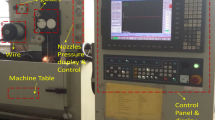Abstract
The quality of WEDM surface is still a concern to the researcher. Due to the uneven spark, the energy discharge transferred to the workpiece surface is not accurate for high-quality machining. Such energy is mainly controlled by process variables and electrode parameters. The selection of proper wire electrode and the proper combination of process variables can extend the surface quality into a much higher limit. In the present investigation, machining quality of brass wire, silver-coated brass wire, and zinc-coated brass wire is compared at different discharge energy levels. The quality of machining is measured in terms of average roughness, maximum roughness, kerf width, recast layer thickness, workpiece surface, and elemental inclusions in both wire and workpiece surface. The surface morphologies of the wire have also been investigated. The research material has been carefully chosen as one of the expensive grades of steel named maraging steel 300 due to its wide applicability in the aerospace and automobile industries. From the investigation, it has found that a minor coating of silver over plain brass significantly improves the surface quality. It has also found that, for better quality machining, discharge energy should be kept in a lower limit. Zinc coating over brass improves the strength of the wire as well as machining rate but simultaneously is responsible for the poor quality of surface. Brass wire is neither a good choice for high surface quality machining nor good for high-speed machining. The majority of copper and some zinc elements have been flush out from wire and adhered to the workpiece surface.











Similar content being viewed by others
Abbreviations
- BW:
-
Brass wire
- EDX :
-
Energy dispersive X-ray
- IP:
-
Current (A)
- SCBW:
-
Silver-coated brass wire
- SDE:
-
Specific discharge energy
- SEM:
-
Scanning electron microscope
- SV:
-
Servo gap voltage (V)
- Ton :
-
Pulse on time (μs)
- Toff :
-
Pulse off time (μs)
- WEDM:
-
Wire electric discharge machining
- ZCBW:
-
Zinc-coated brass wire
References
Jain VK (2002) Advanced machining processes. Allied Publishers Pvt, Ltd, Mumbai
Liao YS, Huang JT, Su HC (1997) A study on the machining— parameters optimisation of wire electrical discharge machining. Jn Mater Process Technol 71:487–493
Song KY, Chu CN (2013) V-grooving using a strip EDM. Int J Precis Eng Manuf 14(12):2061–2066
Ho KH, Newman ST (2003) State of the art electrical discharge machining (EDM). International Journal of Machine Tools and Manufacture 43(13):1287–1300
Ho KH, Newman ST, Rahimifard S, Allen RD (2004) State of the art in wire electrical discharge machining (WEDM). Int J Mach Tools Manuf 44(12):1247–1259
Tosun N, Cogun C, Tosun G (2004) A study on kerf and material removal rate in wire electrical discharge machining based on Taguchi method. J Mater Process Technol 152:316–322
Puri AB, Bhattacharyya B (2003) An analysis and optimisation of the geometrical inaccuracy due to wire lag phenomenon in WEDM. Int J Mach Tool Manu 43:151–159
Tosun N (2003) The effect of the cutting parameters on performance of WEDM. KSME international journal 17(6):816–824
Rakwal D, Bamberg E (2009) Slicing, cleaning and kerf analysis of germanium wafers machined by wire electrical discharge machining. J Mater Process Technol 209(8):3740–3751
Gupta K, Jain NK (2014) Comparative study of wire-EDM and hobbing for manufacturing high-quality miniature gears. Mater Manuf Process 29(11–12):1470–1476
Goswami A, Kumar J (2014) Investigation of surface integrity, material removal rate and wire wear ratio for WEDM of Nimonic 80A alloy using GRA and Taguchi method. Engineering Science and Technology, an International Journal 17(4):173–184
Aggarwal V, Khangura SS, Garg RK Parametric modeling and optimization for wire electrical discharge machining of Inconel 718 using response surface methodology. Int J Adv Manuf Technol. https://doi.org/10.1007/s00170-015-6797-8
Chalisgaonkar R, Kumar J (2016) Investigation of the machining parameters and integrity of the work and wire surfaces after finish cut WEDM of commercially pure titanium. J Braz Soc Mech Sci Eng. https://doi.org/10.1007/s40430-015-0335-3
Manjaiah M, Narendranath S, Basavarajappa S, Gaitonde VN (2015) Effect of electrode material in wire electro discharge machining characteristics of Ti50Ni50−xCuxshape memory alloy. Precis Eng 41:68–77
Pramanik A, Basak AK, Prakash C (2019) Understanding the wire electrical discharge machining of Ti6Al4V alloy. Heliyon 5:e01473. https://doi.org/10.1016/j.heliyon.2019.e01473
Nourbakhsh F, Rajurkarb KP, Malshe AP, Jian C (2013) Wire electro-discharge machining of titanium alloy. Procedia CIRP 5:13–18
Sen R, Choudhuri B, Barma DJ, Chakraborti P (2018) Optimization of wire EDM parameters using teaching learning based algorithm during machining of maraging steel 300. Materials Today: Proceedings 5:7541–7551
Sen R, Choudhuri B, Barma DJ, Chakraborti P (2018) Study the impact of process parameters and electrode material on wire electric discharge machining performances. Materials Today: Proceedings 5:7552–7560
Sen R, Choudhuri B, Barma DJ, Chakraborti P (2018) Experimental investigation and optimisation of WEDM process for machining maraging steel using neural network based Jaya algorithm. Int. J. Machining and Machinability of Materials Vol. 20(4)
Liao YS, Yu YP (2004) Int J Mach Tool Manu 44:1373
Liao YS, Chuang TJ, Yu YP (2014) Int J Adv Manuf Technol 70:2051
Chena Z, Moverarea J, Penga RL, Johansson S (2016) Surface integrity and fatigue performance of Inconel 718 in wire electrical discharge machining. Procedia CIRP 45:307–310
Author information
Authors and Affiliations
Corresponding author
Additional information
Publisher’s note
Springer Nature remains neutral with regard to jurisdictional claims in published maps and institutional affiliations.
Rights and permissions
About this article
Cite this article
Sen, R., Choudhuri, B., Barma, J.D. et al. An investigation on the effect of different coated electrodes on the surface quality of WEDM by varying discharge energy level. Int J Adv Manuf Technol 106, 3285–3299 (2020). https://doi.org/10.1007/s00170-019-04813-9
Received:
Accepted:
Published:
Issue Date:
DOI: https://doi.org/10.1007/s00170-019-04813-9




